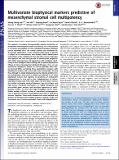Multivariate biophysical markers predictive of mesenchymal stromal cell multipotency
Author(s)
Lee, Wong Cheng J.; Shi, Hui; Poon, Zhiyong; Nyan, Lin Myint; Kaushik, Tanwi; Shivashankar, G. V.; Chan, Jerry K. Y.; Lim, Chwee Teck; Han, Jongyoon; Van Vliet, Krystyn J; ... Show more Show less
DownloadLee-2014-Multivariate biophys.pdf (2.339Mb)
PUBLISHER_POLICY
Publisher Policy
Article is made available in accordance with the publisher's policy and may be subject to US copyright law. Please refer to the publisher's site for terms of use.
Terms of use
Metadata
Show full item recordAbstract
The capacity to produce therapeutically relevant quantities of multipotent mesenchymal stromal cells (MSCs) via in vitro culture is a common prerequisite for stem cell-based therapies. Although culture expanded MSCs are widely studied and considered for therapeutic applications, it has remained challenging to identify a unique set of characteristics that enables robust identification and isolation of the multipotent stem cells. New means to describe and separate this rare cell type and its downstream progenitor cells within heterogeneous cell populations will contribute significantly to basic biological understanding and can potentially improve efficacy of stem and progenitor cell-based therapies. Here, we use multivariate biophysical analysis of culture-expanded, bone marrow-derived MSCs, correlating these quantitative measures with biomolecular markers and in vitro and in vivo functionality. We find that, although no single biophysical property robustly predicts stem cell multipotency, there exists a unique and minimal set of three biophysical markers that together are predictive of multipotent subpopulations, in vitro and in vivo. Subpopulations of culture-expanded stromal cells from both adult and fetal bone marrow that exhibit sufficiently small cell diameter, low cell stiffness, and high nuclear membrane fluctuations are highly clonogenic and also exhibit gene, protein, and functional signatures of multipotency. Further, we show that high-throughput inertial microfluidics enables efficient sorting of committed osteoprogenitor cells, as distinct from these mesenchymal stem cells, in adult bone marrow. Together, these results demonstrate novel methods and markers of stemness that facilitate physical isolation, study, and therapeutic use of culture-expanded, stromal cell subpopulations.
Date issued
2014-10Department
Massachusetts Institute of Technology. Department of Biological Engineering; Massachusetts Institute of Technology. Department of Electrical Engineering and Computer Science; Massachusetts Institute of Technology. Department of Materials Science and Engineering; Singapore-MIT Alliance in Research and Technology (SMART)Journal
Proceedings of the National Academy of Sciences
Publisher
National Academy of Sciences (U.S.)
Citation
Lee, Wong Cheng, Hui Shi, Zhiyong Poon, Lin Myint Nyan, Tanwi Kaushik, G. V. Shivashankar, Jerry K. Y. Chan, Chwee Teck Lim, Jongyoon Han, and Krystyn J. Van Vliet. “Multivariate Biophysical Markers Predictive of Mesenchymal Stromal Cell Multipotency.” Proceedings of the National Academy of Sciences 111, no. 42 (October 8, 2014): E4409–E4418.
Version: Final published version
ISSN
0027-8424
1091-6490